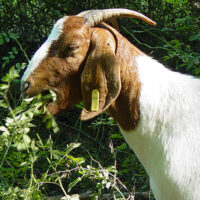 Purdue University - Extension - Forestry and Natural Resources
Purdue University - Extension - Forestry and Natural Resources
Got Nature? Blog
Prescribed or targeted grazing has been used on Western rangelands for many years to manage range weeds and is also used to reduce fuel and maintain fire breaks in high fire hazard areas. It has also been used in the south to help control kudzu.
In a recent study, Purdue Extension forester Ron Rathfon tested goat grazing as a method to control a continuous stand of mature, dense multiflora rose in the understory of one of the timber stands at the Southern Indiana Purdue Agricultural Center (SIPAC). After the steep slope resisted a few rounds of prescribed fire and conventional methods like cutting and spraying were deemed impractical due to the terrain and the thick growth of thorny rose, Rathfon decided to give the animals a try at reducing the invasive species.
The results of Rathfon’s five-year experiment were recently published in the journal Restoration Ecology (Volume 29, Issue 4, May 2021) in an article titled “Effects of prescribed grazing by goats on non-native invasive shrubs and native plant species in a mixed hardwood forest.” Rathfon co-authored the publication with professor of forest ecology Dr. Mike Jenkins, and master’s degree alumna Skye Greenler.
“Although prescribed grazing is not new, no research has been published demonstrating its use for invasive brush species management in eastern hardwood forests and quantifying its impacts on native vegetation,” Rathfon explained. “The goal was to test the use of the goats to control invasive woody brush species as a first step in restoring degraded hardwood forests. I anticipated the goats would reduce understory plant cover. What I didn’t know is how long it would take or whether native vegetation would be more severely impacted than the targeted invasive plants.”
Rathfon and his cohorts varied the goat stocking rate (16 vs. 32-48 goats per acre) and also the number of times a plot was grazed during a growing season (once or twice). Goats were not left in the woods continuously throughout the growing season. When they consumed all green leaves, they were removed, to prevent serious long-term damage to the trees, which had occurred with past livestock grazing in woodlands.
Resources:
What are invasive species and why should I care?, Purdue Extension-Forestry and Natural Resources Blog
Invasive Plant Series: Swallow-worts, The Education Store, Purdue Extension resource center
Mile-a-Minute Vine, The Education Store
Planting Forest Trees and Shrubs in Indiana, The Education Store
Invasive Species Playlist, Purdue Extension-Forestry and Natural Resources YouTube Channel
Report Invasive Species, Purdue Invasive Species
The GLEDN Phone App – Great Lakes Early Detection Network
EDDMaps – Early Detection and Distribution Mapping System
Indiana Department of Natural Resources: Invasive Species
Indiana Invasive Species Council
Cooperative Invasive Species Management Area (CISMA)
Wendy Mayer, FNR Communications Coordinator
Purdue University Department of Forestry and Natural Resources

Recent Posts
- Report Spotted Lanternfly – Purdue Landscape Report
Posted: April 10, 2024 in Alert, Forestry, Invasive Insects, Plants, Wildlife, Woodlands - Declining Pines of the White Variety – Purdue Landscape Report
Posted: in Alert, Disease, Forestry, Plants, Wildlife, Woodlands - Are you seeing nests of our state endangered swan? – Wild Bulletin
Posted: April 9, 2024 in Alert, Forestry, How To, Wildlife - Cicadas in Spring! – Purdue Landscape Report
Posted: in Forestry, Plants, Safety, Wildlife - New Deer Impact Toolbox
Posted: April 7, 2024 in Forestry, Land Use, Plants, Publication, Safety, Wildlife, Woodlands - 2024-25 Fishing Guide now available – Wild Bulletin
Posted: April 4, 2024 in Alert, Aquaculture/Fish, Aquatic/Aquaculture Resources, How To, Ponds, Wildlife - Help Research Chronic Wasting Disease – Wild Bulletin
Posted: April 3, 2024 in Disease, Forestry, How To, Safety, Wildlife, Woodlands - Indiana Reptiles and Amphibians – IFWOA Webinar
Posted: April 1, 2024 in Forestry, How To, Webinar, Wildlife, Woodlands - Birding through the Seasons – IFWOA Webinar
Posted: in Forestry, How To, Webinar, Wildlife, Woodlands - Look Out for Invasive Carp in Your Bait Bucket – Wild Bulletin
Posted: March 31, 2024 in Alert, Aquaculture/Fish, Aquatic/Aquaculture Resources, Invasive Animal Species, Wildlife
Archives
Categories
- Alert
- Aquaculture/Fish
- Aquatic/Aquaculture Resources
- Ask the Expert
- Christmas Trees
- Community Development
- Disease
- Drought
- Forestry
- Forests and Street Trees
- Gardening
- Got Nature for Kids
- Great Lakes
- How To
- Invasive Animal Species
- Invasive Insects
- Invasive Plant Species
- Land Use
- Natural Resource Planning
- Nature of Teaching
- Plants
- Podcasts
- Ponds
- Publication
- Safety
- Timber Marketing
- Uncategorized
- Urban Forestry
- Webinar
- Wildlife
- Wood Products/Manufacturing
- Woodland Management Moment
- Woodlands
